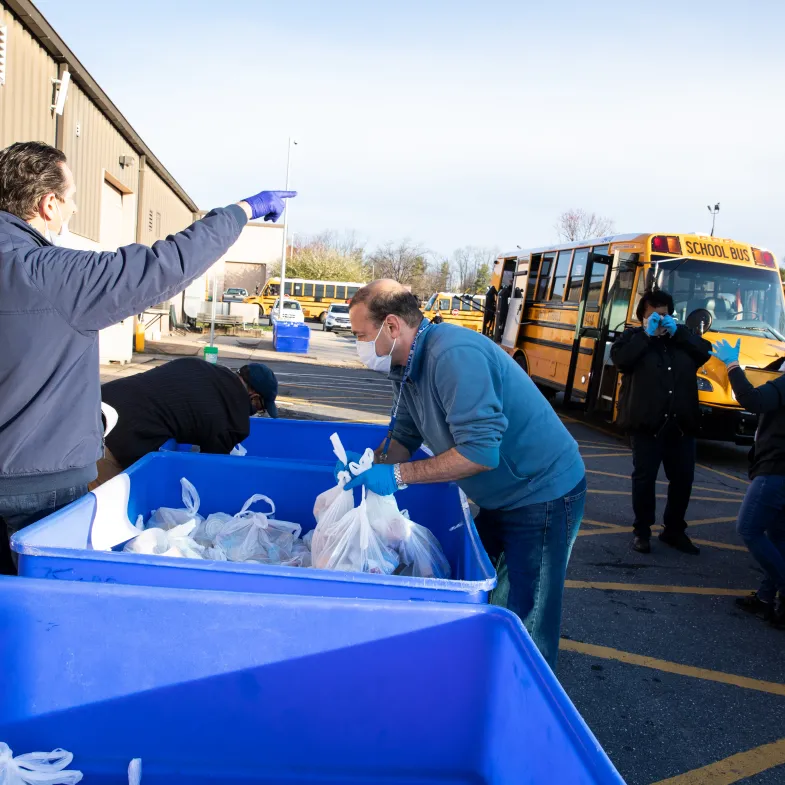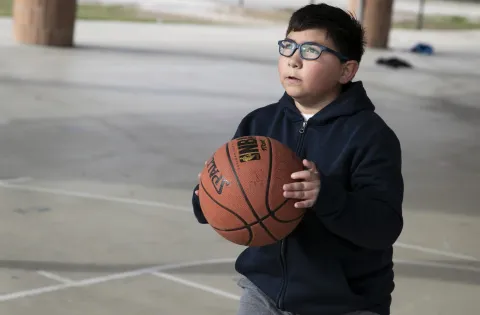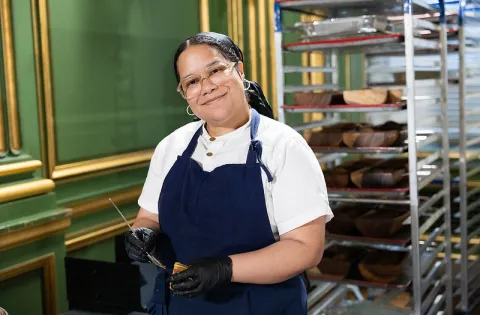2020 has been a devastating year for the United States, as a global pandemic has killed nearly 300,000 Americans and left many more facing hunger and poverty.
But amidst the devastation, there are stories of hope - among them, folks all over our country that have moved mountains to ensure kids in America have the food they need.
School nutrition staff have emerged as unsung heroes, working day in and day out, at times putting their own health at risk to serve students with a smile. At the same time, champions have rallied around childhood hunger like never before, using their voices to draw attention to the impact the pandemic has had and build awareness of critical programs that exist to make sure kids and families have enough to eat.
There are thousands of examples we could point to, and while we regret that we can’t list all of them, our gratitude goes out to each and every one.
Please join us in a big round of applause for these 10 people and the many others like them:
School nutrition staff served up food (and fun) for hungry kids in Maryland
It’s harder to feed kids when they’re not in school, but school nutrition staff nationwide have stepped up to meet the challenge - innovating and working around the clock to feed kids.

Many have gotten creative along the way, like in Charles County, Maryland, where food and nutrition staff have hosted theme days to make meal pick-up fun. They’ve had Pirate Day, Ninja Day, Disney Tea Party, Unicorn Day, and even an “All the Holidays in One Day,” because what is time in 2020?
For Halloween, they hosted their biggest party yet, a “Trunk or Treat” where staff - dressed as witches, ballerinas and pumpkins - decorated their cars and handed out Halloween candy alongside nutritious meals for kids. The theme days boost participation - meaning more kids are getting fed - while also bringing joy and a bit of normalcy during what’s been a difficult time for students, parents and staff alike.
The Emmy® Awards raised critical funds for No Kid Hungry while putting America’s hunger crisis front and center for millions of viewers

In addition to recognizing the best in television, the 72nd Emmy® Awards also made another important group the talk of the red carpet– our nation’s hungry kids.
Each of the nominated networks and streaming partners committed $100,000 per Emmy win to No Kid Hungry. Along with a generous $500,000 from the Television Academy, the Emmy Awards raised $2.8 million to help feed kids during this crisis and in the long recovery ahead.
Celebrities have used their platforms to raise both money and awareness
As hunger has become even more widespread this year, it has also become more visible. Many celebrities stepped up to lend their voice to this critical issue. Whether it was reading their favorite children’s books on Instagram for the #SaveWithStories campaign or auctioning off amazing experiences through the All In Challenge, hundreds of performers, athletes, musicians and artists have used their platforms to raise awareness and promote generosity toward those impacted by this crisis.
And No Kid Hungry was honored to welcome Viola Davis as our newest national spokesperson this year, alongside Jeff Bridges and Stephen & Ayesha Curry. Viola hit the ground running at a critical time for kids, urging Congress to strengthen federal nutrition programs.
A Washington, DC chef and restaurant owner provided meals for the community while keeping restaurant workers employed

Even though this crisis has put the future of many restaurants in jeopardy, chefs and culinary professionals are still serving their communities, finding innovative ways to feed hungry kids and others who are vulnerable. In Washington, DC, chef and restaurateur Erik Bruner-Yang founded the Power of 10 Initiative to re-employ laid off restaurant workers and keep local restaurants open while providing meals to essential employees and families facing hunger.
Bruner-Yang’s 'Power of 10' teamed up with MedStar Georgetown University Hospital and No Kid Hungry to deliver healthy, restaurant-prepared heat and serve meals - alongside nutrition education materials - to some of DC’s most vulnerable families. The results of the pilot were striking - food insecurity among participating families decreased from 75% to 21% over the 10-week period.
Lawmakers championed federal programs and flexibilities that made it possible to feed kids during a pandemic
When school buildings closed and classes went virtual, one of our biggest concerns was how kids who rely on school meals would get the nutrition they need. Fortunately, federal lawmakers championed temporary program flexibilities and expanded federal nutrition programs to make sure kids never stopped being fed.
The USDA issued nationwide child nutrition waivers, which have been crucial in giving schools and community organizations the flexibility to feed kids learning virtually and meet increased need in their communities. And Pandemic EBT (P-EBT) has ensured that kids who typically rely on school meals don’t lose an important source of nutrition when schools are closed by providing a supplemental benefit that can be used to buy groceries.
A coalition of leaders in Virginia created a Road Map to End Hunger
State and local community leaders have been instrumental in making sure kids have the nutrition they need during this crisis, from allocating CARES Act funding for child nutrition programs to outreach to eligible families around SNAP and Pandemic EBT.

Collaboration has been key. In Virginia, a coalition of leaders came together to produce the Virginia Roadmap to End Hunger, a cohesive set of goals and strategies to improve food security in the state. The Roadmap, produced by Governor Northam’s Children’s Cabinet, outlines strategies for ensuring Virginia’s children have consistent and reliable access to healthy foods during this crisis and in its aftermath. Expanding and improving participation in child nutrition programs are key priorities of the roadmap, including school breakfast, the Community Eligibility Provision, summer meals and SNAP.
An anti-hunger group in Arizona built tribal coalitions to improve food security in Native American communities

COVID-19 has had a devastating impact among Arizona’s 20+ sovereign tribal nations, which already faced disproportionate rates of food-insecurity pre-pandemic. The Arizona Food Bank Network has created coalitions within San Carlos Apache, White Mountain Apache and Tohono O’Odham nations, working alongside tribal leaders to address the health and hunger crises threatening their communities.
Through a partnership between the Arizona Food Bank Network and grassroots organizations including the Native American Advancement Foundation and Nalwoodi Denzhone Community, the work has included community-led research on the root causes of childhood hunger in tribal communities and a weekly coalition call that brings together tribal elders, food banks and other activists. The collaboration continues to unfold, focused on long-term, sustainable solutions to hunger.
A celebrity trainer used the power of community and fitness to make sure kids are fed in this time of crisis

When thousands of people started joining his free Torch’d workout on Instagram back in March, celebrity trainer, choreographer and Broadway dancer Isaac Calpito wanted to use his platform to give back. He partnered with No Kid Hungry and has since raised more than $1 million by encouraging those who tune in to get Torch’d to pay it forward by making a donation.
Isaac, who has said he was inspired in part by his own experience with the federal nutrition programs as a kid growing up in Hawaii, has shown us what can be achieved with an innovative spirit and a generous community.
A California superintendent is making sure the next generation of changemakers is fed, in her hometown and all across the country

Dr. Maribel Garcia has been a longtime champion for kids in El Monte, California, where she went to school herself before becoming a teacher and then superintendent. Even before the pandemic her district, where 94% of students are eligible for free and reduced price meals, was offering universal free breakfast and lunch to all students, along with a warm supper every day. During school closures this spring, they served 1.5 million meals in the community.
Dr. Garcia has lent her voice to the issue of childhood hunger well beyond California through appearances on CNN and our Dine Shop Share campaign. Share Our Strength (the parent organization of the No Kid Hungry campaign) was lucky to welcome Dr. Garcia to our board of directors this year, where her passion and expertise will impact kids nationwide!
Parents have juggled enormous responsibility as they’ve balanced wearing many different hats
This was an incredibly stressful year for parents, as many found themselves juggling new responsibilities and struggling to make ends meet. With schools and daycares closed or operating limited hours, many have had to work while also caring for kids at home. For parents that are working from home, that may mean helping with distance learning between Zoom calls. For essential workers, it could be trying to find a friend or family member to watch their kids while they work their shift. For some it meant visiting food banks for the first time and navigating new benefits programs. To all, our hats go off to you.
Our list wouldn’t be complete without thanking you. Whether you’ve donated your money or your voice to amplify our cause, you’ve had an incredible impact when it comes to making sure no kid goes hungry during this pandemic.



